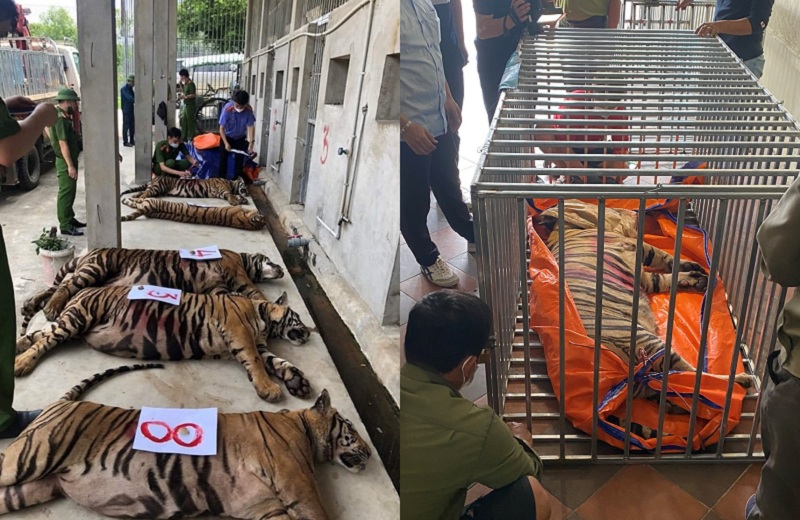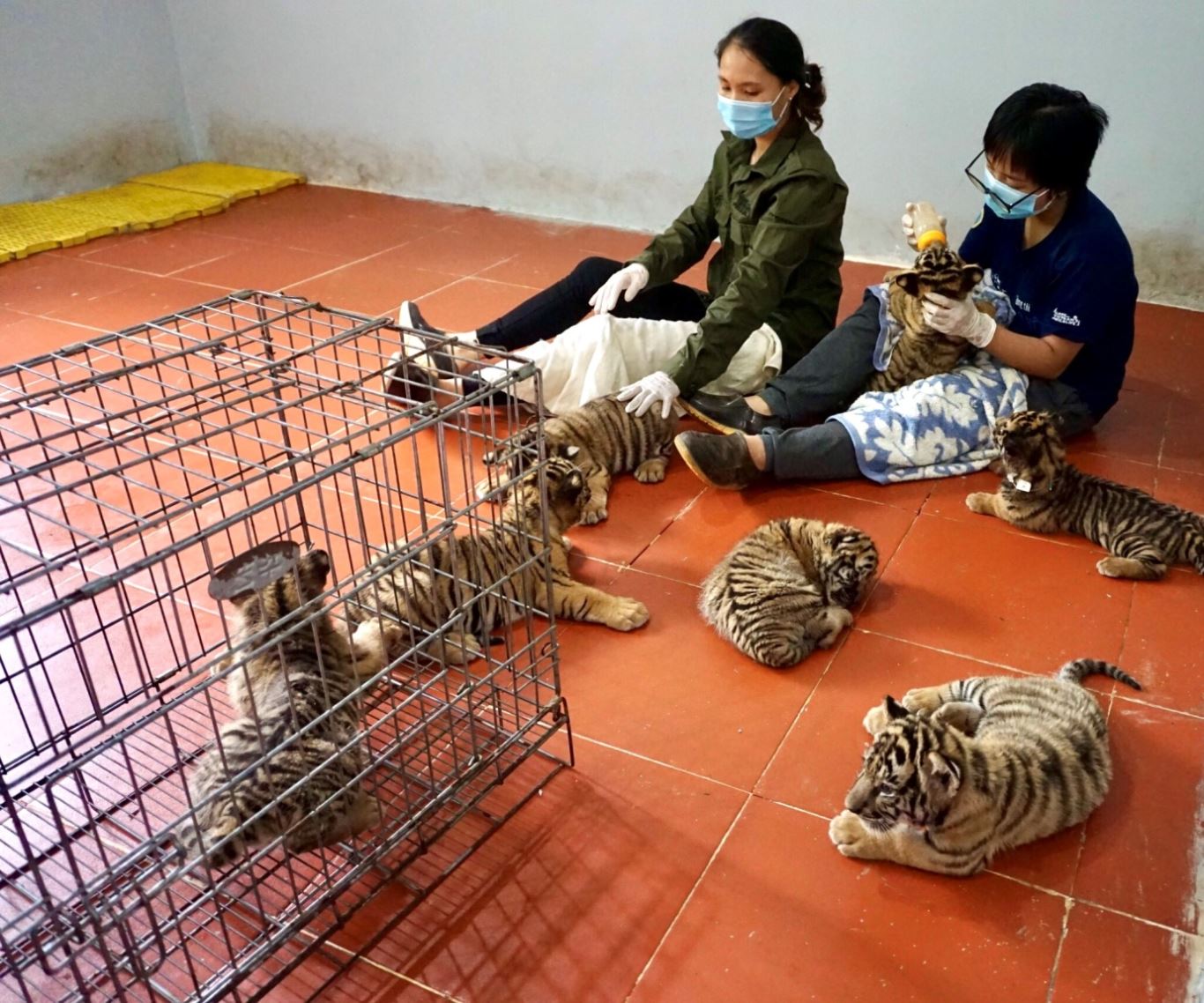

29/10/2021
In the early days of August 2021, Nghệ An Provincial Police discovered and confiscated 24 tigers that were illegally bred and transported in 2 districts of Diễn Châu and Yên Thành. Unfortunately, eight tigers died during the confiscation process, raising public questions about the responsibility of the parties involved in the tiger's death. However, from the point of view of conservation, what is needed now is to draw lessons from the rescue and conservation of tigers, it's not just the story of the dead tiger.
There should be a fair view around the death of 8 tigers
For many years, the three districts of Diễn Châu, Yên Thành and Quỳnh Luu have been known as the hottest spots in Việt Nam for the illegal tiger farming and trade. After the investigation and monitoring process, on 1st August, the Nghệ An Provincial Police arrested 2 people for illegally transporting 7 tiger cubs from Hương Sơn District, Hà Tĩnh Province to Nghệ An for consumption. Then, on August 4th, Nghệ An Provincial Police mobilized many forces to coordinate with functional agencies to inspect two houses in Đô Thành Commune (Yên Thành District, Nghệ An Province), and discovered that they were raising 17 adult tigers, each weighing hundreds of kilograms. These tigers, after being anesthetized, examined and sampled for assessment, were transported to two eco-tourism areas in Diễn Châu District (Nghệ An) to take care of. However, unfortunately on August 6th, the authorities confirmed that 8 of them had died. These are two of many cases of Law violation related to tigers discovered and handled by the police force in Nghệ An Province recently.

The case of 17 tigers was "rescued" in illegal captive households in Nghe An
The cause of the eight tigers' deaths has not yet been determined. However, initially, experts assumed that there were some possible causes for the death of 8 tigers, such as: prolonged anesthesia, long-distance transportation in hot weather affecting the health of tigers, farmed tigers have weaker health than wild tigers … The investigation showed that the confiscated tigers lived for a long time in conditions of cages, care and inappropriate food. Each individual with an average weight of 200 - 250 kg, but has to live in cramped, moldy, lack of light and do not enjoy basic animal rights. It is these living conditions that seriously affect their physical and mental health, increasing the risk of diseases such as obesity, osteoarthritis, cardiovascular and neurological depression.
The discovery of 17 tigers and those who specialize in captive breeding and trading of tigers is a big step forward for the authorities of Nghệ An Province to eliminate the situation of captive breeding and illegal tiger trade that has been very complicated in Việt Nam in general and Nghệ An in particular. However, besides that, there are also conflicting information and opinions, there are opinions not in favor of illegal tiger farming and opinions in favor of illegal tiger breeding facilities, blaming the authorities for the deaths of 8 tigers. However, through this incident, we need to have a fairer view on this issue.
First of all, it is necessary to clearly recognize that the possession and trade of tigers and tiger products are an illegal act and criminally handled under Vietnamese Law. Therefore, the concurrence and support for illegal tiger farming facilities means that it does not respect the law system in Việt Nam, as well as abets wrongdoings, causing serious and long-term consequences for tiger conservation in Vietnam and around the world. Only when the use of tiger products and the illegal trade, transportation and keeping of tigers are prevented, can conservation of this group of species be effective. Without the above-mentioned arrests, not only all 24 tigers would be killed, but in the future, hundreds of other tigers would continue to be held captive and killed to gain illicit profits. It can be said that this arrest is the largest number of tigers in captivity and illegally transported in Việt Nam ever. Nghệ An Province's police are fierce in their work in sweeping and handling illegal wildlife trade, transportation and keeping activities in general and tigers in particular in order to join hands in Vietnamese wildlife conservation shows the spirit of respect for the law and is highly appreciated.
Second, facilities that keep, or breed, tigers with the intention of providing tigers, tiger parts and products for commercial purposes, not conservation purposes. These tiger farms have no conservation value and are creating a major barrier to the protection and restoration of wild tiger populations, through stimulating markets for tigers and tiger products, as well as normalize the trade and use of tigers. This makes it difficult for law enforcement and also abets the transcontinental illegal wildlife trade. It is the fourth largest type of crime in the world, behind only arms trafficking, drug trafficking and human trafficking. The growth of the wild species market has pushed many rare animals to the brink of extinction such as Java one-horned rhinoceros, Indochinese tiger, Asian elephant, saola, sarus crane...
Third, the tigers confiscated this time were born or domesticated in captivity, so they have lost all their wild instincts and natural behaviors. It can be confirmed that tigers in captivity do not have or have lost the ability to hunt and survive in the wild, leading to their very low chance of survival when they are released back into the wild. To survive, they need the skills of running, hunting, stalking and defending the territory. The release of these tigers back into the wild increases the risk of tiger attacks and endangers humans. Not only that, but the released tigers will also bring negative effects to the wild tiger population and other animals. Recessive gene in individuals born of inbreeding can affect and cause undesirable changes to the natural genetic resources. In addition, pathogens arising from illegal captive breeding, transportation and trade can spread dangerous diseases to wildlife and humans.
Fourth, transferring these tigers to licensed units with good care conditions and facilities that ensure animal welfare is the most appropriate and humane choice at the moment. In addition to providing a better life for them, opening to visitors to provide a financial resource to support animal care, as well as raising public awareness about wild nature conservation. However, in reality, not many units agree to receive these individuals. Most of the large zoo and safari units in Vietnam have received enough tigers within the allowable limit. In addition, the cost of food, care and ensuring a suitable habitat for tigers is very high. This is a great burden challenging in transferring and receiving of confiscated tigers. Wildlife Rescue Centers managed by Government Agencies or non-profit organizations are no exception. Most of the centers have limited space, only receive a certain number of animals, so they cannot accept all the animals that are not able to re-release.
Some recommendations from the case of arresting captive tiger in Nghệ An
Currently, the legal regulations related to the illegal captive breeding, storage, transportation and trade of wildlife have basically been completed. Along with the Penal Code, the Law on Handling of Administrative Violations, the Law on Forestry, the Law on Biodiversity..., relevant legal documents on management of endangered, precious and rare plants and animals have also been widely disseminated and propagated for law enforcement agencies and people to implement. Although there have been positive changes in the law, people's awareness has been enhanced, but in reality, there are still many challenges in protecting rare and precious wildlife, more urgent and drastic solutions are needed to end this situation.

7 tiger cubs are being cared for in special care at Pù Mát National Park's Wildlife Rescue Center
From the tiger capture incident in Nghệ An, it is necessary to draw profound lessons on animal rescue. It needs to develop clear, scientific procedures for the confiscation, handling and management of live tigers captured in Việt Nam, including their transfer to reputable rescue centers (not allowed to breed), take individual identification samples so that they can be compared with existing databases, and continue to monitor to ensure that these tigers are not returned to the illegal market.
Conduct an inspection of existing tiger holding facilities. According to WWF, there are about 300 tigers in captivity in Việt Nam. Identifying all captive tigers by attaching an electronic chip, collecting genetic samples and take pictures to identify each individual's characteristic stripes to compile into a common database of captive tigers. In this way, it is possible to trace the origins of tigers in the market based on the database, while ensuring that tiger breeding facilities do not serve the illegal demand for tigers and products from tigers.
Private tiger breeding facilities should be closed, except for scientific research, education and conservation purposes. In addition, it is necessary to tighten the licensing of commercial wildlife farming; revoke licenses for tiger farms without sufficient legal evidence; strictly handle local officials who corrupt, cover up and collude for illegal tiger farming activities.
Enhance the responsibility of local authorities in controlling, managing and ending the illegal wildlife trade and consumption in the area. There should be strict penalties for violators. Strengthening the fight against internet crime related to wildlife trade, by shutting down websites that contain information for sale, advertisement, or purchase, selling wildlife; strengthen monitoring and block personal pages on social networks used to sell wildlife, including tigers.
Researching and completing legal provisions to improve the efficiency of state management of wildlife farming, including endangered, precious and rare species; perfecting the Law on Prevention and Handling to create a deterrent; strengthen propaganda on the practice of not hunting, catching, buying, selling, transporting, slaughtering, consuming, storing, advertising or infringing upon wild, endangered and rare animals and plants.
Increase resources in protected areas to prevent poaching and restore tiger prey populations to prepare adequate and safe habitats for small populations in the wild and to re-release tigers into the wild in Việt Nam in the future.
Wildlife conservation in general and tiger conservation in particular is a noble gesture of human towards nature in the era of the industrial revolution 4.0.
Prof. Dr. Đặng Huy Huỳnh
Vietnam Association for Conservation of Nature and Environment
(Source: Vietnam Environment Administration Magazine, English Edition III - 2021)